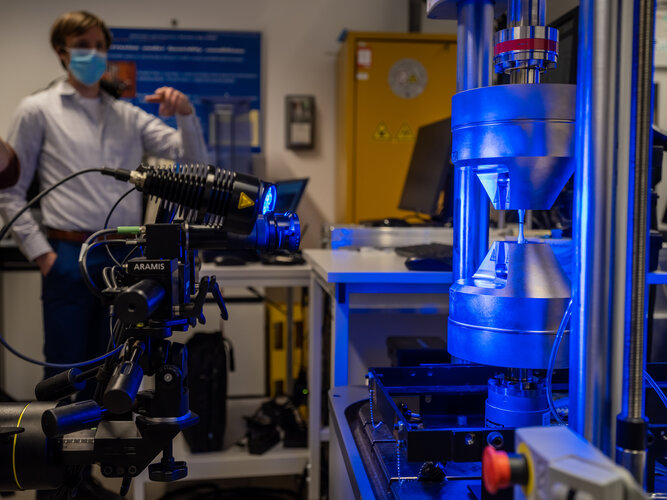
Copernical Team
SwRI scientist helps confirm liquid water beneath Mars south polar cap
 A Southwest Research Institute scientist measured the properties of ice-brine mixtures as cold as -145 degrees Fahrenheit to help confirm that salty water likely exists between grains of ice or sediment under the ice cap at Mars' south pole. Laboratory measurements conducted by SwRI geophysicist Dr. David Stillman support oddly bright reflections detected by the MARSIS subsurface sounding radar
A Southwest Research Institute scientist measured the properties of ice-brine mixtures as cold as -145 degrees Fahrenheit to help confirm that salty water likely exists between grains of ice or sediment under the ice cap at Mars' south pole. Laboratory measurements conducted by SwRI geophysicist Dr. David Stillman support oddly bright reflections detected by the MARSIS subsurface sounding radar Sols 3367-3368: The Prow to take another bow
 The weekend plan included a short drive (or bump) to get us closer to one of the interesting, more resistant ledges that are exposed in this area ("The Prow"), as Curiosity continues her climb up Mount Sharp. These resistant ledges have caught our attention because they reveal distinct textures. Being able to get close-up, high resolution imaging accompanied by compositional data, will help the
The weekend plan included a short drive (or bump) to get us closer to one of the interesting, more resistant ledges that are exposed in this area ("The Prow"), as Curiosity continues her climb up Mount Sharp. These resistant ledges have caught our attention because they reveal distinct textures. Being able to get close-up, high resolution imaging accompanied by compositional data, will help the New control technique uses solar panels to reach desired Mars orbit
 A satellite on a science mission to Mars aims for a low-altitude orbit, but the lower the orbit, the more propellant is required to enter orbit when arriving from Earth. To save propellant, a technique called aerobraking uses a small propulsive maneuver for orbit insertion to enter a large orbit; the satellite then makes many passes through the upper atmosphere, using drag on the solar panels to
A satellite on a science mission to Mars aims for a low-altitude orbit, but the lower the orbit, the more propellant is required to enter orbit when arriving from Earth. To save propellant, a technique called aerobraking uses a small propulsive maneuver for orbit insertion to enter a large orbit; the satellite then makes many passes through the upper atmosphere, using drag on the solar panels to US undermines safety of Russian cosmonaut's at ISS by denying visa, Roscosmos says
 Refusal of the United States to issue an entry visa for Russian cosmonaut Nikolay Chub, who was to undergo training at the NASA space center, threatens his safety during his stay at the International Space Station (ISS), as well as the safety of his US colleagues, Russia's State Space Corporation Roscosmos said on Saturday.
Earlier in the day, a source told Sputnik that the US did not gran
Refusal of the United States to issue an entry visa for Russian cosmonaut Nikolay Chub, who was to undergo training at the NASA space center, threatens his safety during his stay at the International Space Station (ISS), as well as the safety of his US colleagues, Russia's State Space Corporation Roscosmos said on Saturday.
Earlier in the day, a source told Sputnik that the US did not gran Five Space Station Research Results Contributing to Deep Space Exploration
 More than 3,000 experiments have been conducted aboard the International Space Station during the 21 years humans have been living and working in space. These experiments have provided insights helping improve life back on Earth and explore farther into the solar system. Researchers have shared these results in thousands of scientific publications.
Over the past few months, scientists shar
More than 3,000 experiments have been conducted aboard the International Space Station during the 21 years humans have been living and working in space. These experiments have provided insights helping improve life back on Earth and explore farther into the solar system. Researchers have shared these results in thousands of scientific publications.
Over the past few months, scientists shar SpaceX to crash Falcon 9 rocket into Moon
 SpaceX launched its first deep-space mission in February 2015. The uncrewed Falcon 9 transported the refrigerator-sized Deep Space Climate Observatory into the void. However, because it doesn't have enough fuel to return to Earth and land on a floating platform as planned, the rocket will instead be ploughed into the Moon.
In a first, a Space X rocket that has been navigating deep space si
SpaceX launched its first deep-space mission in February 2015. The uncrewed Falcon 9 transported the refrigerator-sized Deep Space Climate Observatory into the void. However, because it doesn't have enough fuel to return to Earth and land on a floating platform as planned, the rocket will instead be ploughed into the Moon.
In a first, a Space X rocket that has been navigating deep space si China tests new engine, 'likely to power hypersonic aircraft'
 China on Monday conducted a test flight for a new engine that experts said could power China's future hypersonic aircraft and near-space plane.
The engine, developed by the Laboratory of Spray Combustion and Propulsion under School of Aerospace Engineering at Tsinghua University, successfully conducted a flight test on Monday morning, China Central Television (CCTV) reported.
A two
China on Monday conducted a test flight for a new engine that experts said could power China's future hypersonic aircraft and near-space plane.
The engine, developed by the Laboratory of Spray Combustion and Propulsion under School of Aerospace Engineering at Tsinghua University, successfully conducted a flight test on Monday morning, China Central Television (CCTV) reported.
A two Warpspace wins JAXA contract to design Optical Cislunar Communication Architecture for Lunar mission
 Warpspace Co., Ltd., a spin-out space startup from the University of Tsukuba, an optical inter-satellite communication service provider, announced that it has been selected to conduct a study on space communication for the lunar exploration by JAXA, which could be a part of the Artemis plan. Warpspace develops "WarpHub InterSat," the optical inter-satellite data relay communication service for t
Warpspace Co., Ltd., a spin-out space startup from the University of Tsukuba, an optical inter-satellite communication service provider, announced that it has been selected to conduct a study on space communication for the lunar exploration by JAXA, which could be a part of the Artemis plan. Warpspace develops "WarpHub InterSat," the optical inter-satellite data relay communication service for t EU launches 'game changer' space startup fund

The EU launched Tuesday a billion-euro fund to support startups in the space sector with the hope it will be a "game changer" and attract private investors into the key sector.
Named the Cassini fund after the 17th century Italian astronomer, it was launched as part of the European Investment Fund (EIF) which provides risk financing to small and medium-sized businesses across Europe.
"Many of our startups cannot get sizeable equity investment in the EU once they need to scale up," said Thierry Breton, the EU's internal market commissioner, at a gathering for the European space industry in Brussels.
He said the firms are thus forced to turn to non-EU investors.
"This is a major loss for Europe. The Cassini Fund will be a game changer," he added.
The head of the EIF, Alain Godard, said that each euro the fund invests typically attracts three or four euros of private investment from firms that otherwise would have found the project too risky.
A complementary mechanism will provide access to lending to space startups.
The European space sector is estimated to account for about 10 percent of the overall economy, and is expected to see its revenues double over the coming decade.

 Image:
On the pull
Image:
On the pull 































